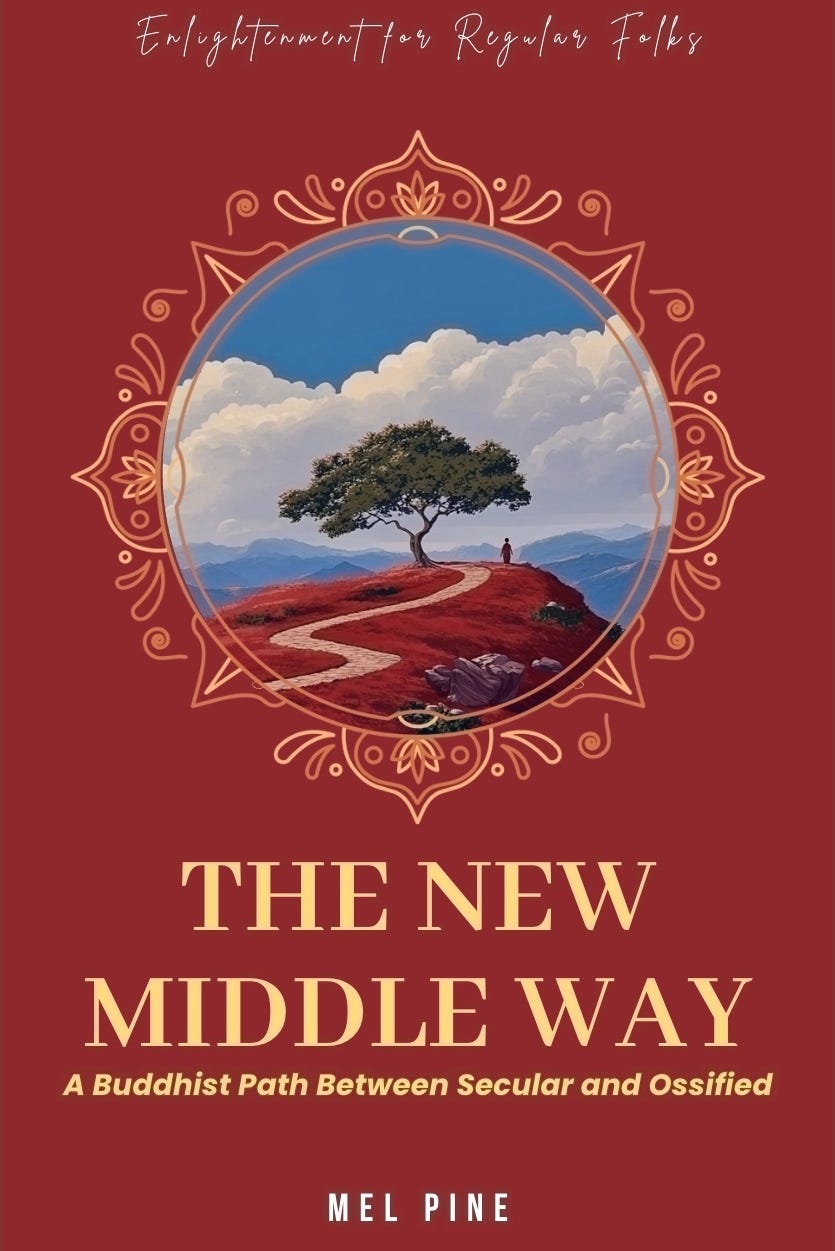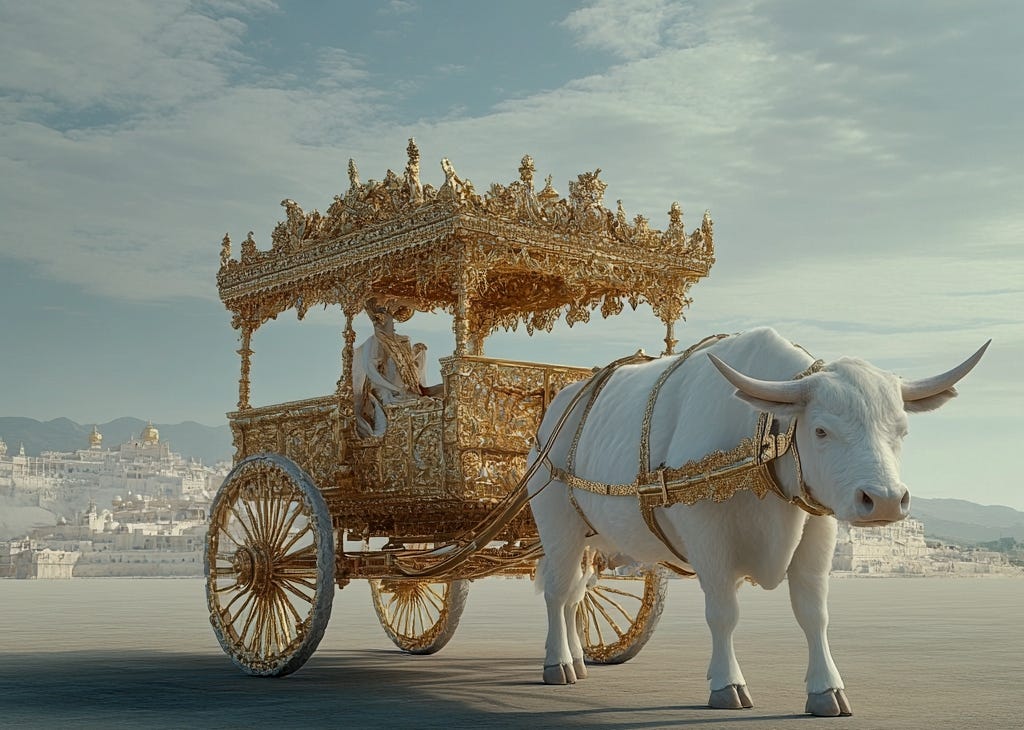On April 10, I posted the Epigraph and Introduction of my forthcoming book, The New Middle Way: A Path Between Secular and Ossified, which is scheduled for publication this summer. Here’s the cover, subject to possible revision:
The book combines explanations of Buddhism for beginners with glimpses of the path that has brought me to a joyful life. The portion I shared on April 10 was largely anecdotal, so I’m now releasing a more teacherish chapter. These two sections will remain available here on my From the Pure Land blog and podcast and on my new website for anyone who’d like to read or listen to a sample of the book.
Some of you have read most of this chapter, which I shared as I drafted it. Here’s the final and expanded version. (But it’s not so final that I can’t tweak it if you spot a mistake and let me know.
Please consider sharing this post or podcast with friends.
The New Middle Way
Chapter 3: Kleshas, the Pāramitās, the Brahmaviharas, and Karma
If you're uptight about Buddhist jargon and Sanskrit words, my intention in this chapter is to help you relax about the jargon as you learn the core Buddhist teachings about how to live. Consider it gentle immersion therapy.
Instead of commandments and sins, the Buddha talked about “skillful” and “unskillful” (kusala and akusala in Sanskrit) actions. Skillful actions reduce suffering and lead toward awakening, while unskillful ones perpetuate suffering and hinder spiritual progress. This framework emphasizes pragmatism over rigid moral rules, focusing on intentions and outcomes rather than notions of good or evil.
Translations of the Buddha’s words into English are fraught with opportunities for misunderstanding. Some translations have him using the word “evil.” Although I’m no linguist, my understanding is that the words he used might be better translated as unskillful or unwholesome.
In Second Wave Buddhism, the word upaya begins to be used as a slight variation on kusala. Upaya is translated as skillful means, usually used to help others, like a teacher changing appearance or language to reach the specific group needing guidance. In the Lotus Sutra, a key text for the Second Wave, the parable of the burning house demonstrates upaya. Here’s a very abbreviated overview of the story:
The Buddha tells of a very rich man who has a huge house that’s ablaze. The man is safely outside, but his children are playing inside and are hard to entice away from their toys and games. It’s impossible for the man to run in, gather his many children, and safely remove them, so he shouts to them that he has brought them three carts that are outside the gate to the house. He describes the specific type of cart appropriate for the age of each child. The children find no carts outside, but the man eventually gives each child a large, bejeweled carriage drawn by a pure white ox. The Buddha makes clear that the father is not guilty of falsehood.
In telling the parable, the Buddha also explains that he tailors his teachings to each level of student.
Buddhist ethics are about living skillfully and employing skillful means to reduce the suffering of all beings, which emphatically includes you. You can’t heal others if you are broken, although you can serve others while in pain. Jane Wilhelm, a wise and dear friend now long gone, was once asked what she did in her times of despair. Her reply:
Whenever I’m feeling sorry for myself, I go find someone to help, and that makes me feel better
I suspect that Jane—an American who had spent her childhood years in what was then called Burma and always remembered fondly the Buddhist culture—knew in her times of despair that she was not broken. She may not have named it, but she understood how to access her Buddha Nature.
Many stories in Buddhism stress that rigid rules need to give way to skillful ways of living. This is one of my favorites:
Two monks—one senior to the other—encounter a young woman stranded at a riverbank. Despite their monastic precepts forbidding physical contact with women, the elder monk carries her across the rushing water. They continue to walk on for hours until the junior monk confronts his mentor: How could you break our vows and touch her? The senior monk replies: I set her down on the other side of the river. Why are you still carrying her?
The lessons from this story are many:
Letting go of attachments: The senior monk could let go of his vows to solve an immediate dilemma. Then, he let go of the woman physically and mentally. The younger monk ruminated judgmentally, which only weighed him down.
Living in the present: The past can’t be changed. Rumination is pointless, bringing more suffering.
Compassion over dogma: I like this story because of its everyday nature. The story doesn’t tell us the woman was starving or in danger of never reaching where she needed to be. She wanted help, and the senior monk gave it. He weighed her mundane need against his mundane precept.
Discernment: The younger monk took a transient distraction and treated it as a moral dilemma.
Lay Buddhists generally have fewer precepts—just five. We endeavor not to take life, take what is not offered, misbehave sexually, lie, or use intoxicants. These are guides to help us live skillfully. My experience in Buddhist communities is that we don’t judge each other’s interpretation of the precepts. Some of us don’t drink or use other intoxicants, some of us are social drinkers and pot smokers, some of us believe that psychedelics are an enhancement along the path.
We are sometimes too laid back for the good of the sangha and the larger community. You’ll find more on that in Chapter 16.
***
It will come as no surprise that Buddhists love to count. Our various numbered lists often overlap, and even items within a list overlap with other items. It’s a throwback to how Buddhism developed—through memorization. In the Buddha’s time in the Indian subcontinent, writing was considered worldly. Sacred teachings were recorded by memorizing passages and numbered lists.
We’ve already mentioned the Five Precepts. Now, we’ll cover the Kleshas, Pāramitās, and Brahmaviharas. We’ll count them as we go along.
Kleshas
The Sanskrit word means afflictions. Sometimes referred to as “poisons,” the kleshas cloud the mind’s inherent purity, trapping beings in the endless cycle of suffering called samsara. The kleshas distort our sense of reality and stand in the way of awakening. A teacher might site three, five, six or more kleshas:
The ”big three” are:
Ignorance: This means a lack of understanding without the common pejorative aspect of the word. In our first year or two of life, the kleshas convince each of us that we are a real and continuing “me” that’s separate from a real and continuing “you” and “them.”
Attachment: Grasping at what we mistakenly believe will make us happy—a new car, a new home, a better job, a different spouse, more money, an injection of Botox. Once we have what we want, it’s not enough, and we grasp for something else.
Aversion: Rejecting and pushing away what we fear will lead us to unhappy feelings—a doctor’s appointment, a person of a different ethnic group or political party, another point of view, a deeper understanding of oneself.
These three are related. We grasp what we think is real—like wealth—and avoid recognizing that it’s an illusion and won’t bring lasting happiness.
Those three cover a lot of ground, but some lists add specifics like:
Pride
Jealousy
Anger
Doubt
Rigidity of viewpoint
Hatred
We overcome kleshas through ethical conduct, meditation, and wisdom. I’d suggest that a simple daily practice, perhaps the most common of all Buddhist practices, grounds us in that effort. That’s reciting:
I take refuge in the Buddha, I take refuge in the dharma, I take refuge in the sangha.
The pāramitās and brahmaviharas, which we’ll discuss below, and the precepts serve as guides to ethical conduct. We can learn how to meditate, but how do we develop wisdom? For me, the answer comes from Vajrayana (Third Wave) Buddhism, and it’s the main reason I feel at home there.
In addition to the wisdom gained from life experience, we develop wisdom through coming, experientially, to understand the Nature of Mind. With the help of awareness meditation, we get to know our mind and make friends with it so that we can calm it—that is, the bada-bada yada-yada part of the mind. When the conceptual mind calms, we can rest in the pure and clear Buddha Nature that sees reality as it is, where our innate wisdom and compassion bring clarity. Words alone won’t get you there. Most of us need a qualified teacher.
You'll come across terms like "Nature of Mind" and "Buddha Nature" repeatedly in this book and throughout Vajrayana Buddhism. In some traditions, it's expressed by the Tibetan word Rigpa. In some, it's called "mind itself." Maybe it has so many names because it can't be grokked conceptually. Imagine reaching a state of pure awareness and clarity without distractions like "you" and "me" and the thoughts that come and go.
Pāramitās
The pāramitās, which are translated as perfections, are rooted in the late stages of the First Wave and early stages of the Second, as the emphasis shifted toward transcending self-centeredness and fostering wisdom and compassion. Again, we have a basic number of perfections and various expanded lists. I find eleven worth attention.
Here are the “big six”:
Generosity. Selfless giving in every sense of the term. We help others in material ways, by spreading the dharma, through acts of compassion, and by listening. In the words of Thich Nhat Hanh: The most precious gift we can offer others is our presence. When mindfulness embraces those we love, they will bloom like flowers.
Ethics. Like the senior monk who carried a woman across a stream and the father who lied to his children, we must evaluate our actions based on how much they relieve or promote suffering. Our choices are not always limited by our precepts and vows.
Patience. A friend of mine always questions the verb “to wait.” What does it mean? Are we fixated on something in the future when we could be resting in and enjoying the current moment? This pāramitā also applies to the time it takes to fully absorb profound truths and to enduring hardships, even those caused by others.
Diligence. Our effort is unwavering in acting virtuously and growing spiritually.
Meditation. The route to understanding beyond cognition requires some form of meditation and contemplation.
Prajñā. I’m using a Sanskrit word here for a specific type of wisdom. It’s the wisdom that comes from experience, cognitive learning, meditation, and practice. You’ll find a different word below for another type of wisdom.
Perfections that are sometimes added:
Jñāna. This wisdom is innate but must be accessed by experiential understanding of the true nature of reality.
Skillful Means. Explored earlier in this chapter.
Aspiration. The solemn vow to work for the liberation of all beings from suffering.
Renunciation. Classically, this is giving up all worldly possessions beyond the bare minimum. In modern practice, it involves cutting attachments.
Loving Kindness. This is implied in generosity and wisdom but sometimes listed on its own.
Equanimity. The disposition to remain steady through life’s ups and downs, sometimes referred to as “one taste.”
Brahmaviharas
The word in Sanskrit translates to “divine abidings,” but the brahmaviharas are generally referred to in English as the Four Immeasurables (because their impact is infinite) or the Sublime Attitudes. The teacher Lama Surya Das, fond of wordplay, sometimes calls them the “Heartitudes.”
They are:
Loving Kindness: An attitude of boundless goodwill toward all beings without attachments or expectations.
Compassion: Arising from loving kindness, it’s the sincere commitment to work to end the suffering of all beings.
Empathetic Joy: Taking delight in the success and happiness of others without envy or resentment.
Equanimity: Remaining balanced and impartial through life’s ups and downs and accepting all beings as equal.
The Four Immeasurables are often recited as a prayer along these lines:
May all beings have happiness and its causes.
May all beings be free from suffering and its causes.
May all beings remain unseparated from a supreme joy that is beyond all sorrow.
May all beings abide in equanimity free from attachment, aversion, and bias.
Karma
The word “karma” comes from a Sanskrit root meaning “action” or “deed.” Because it carries much misleading baggage in informal Western use, we’ll start by talking about the core Buddhist concept of causes and conditions.
Everything we see, hear, smell, taste, feel (physically or emotionally), or think arises from an interdependent web of causal relationships. Everything in the world as we know it results from causes and conditions. Everything we do or even think contributes to that web of causality. This results in a process called Dependent Origination in which beings are trapped in a cycle of repeated suffering unless they can awaken to and from it.
If the idea is new to you, take a deep breath and don’t get stuck on it. Just grok that stuff causes everything, and everything causes stuff.
Now, think about karma—an action or deed. That’s stuff. Every action or deed—even a thought—results from causes and conditions and adds to causes and conditions. Our free will is part of that. If we didn’t have any free will, what would be the point of discussing it? Even our free will, though, is influenced by causes and conditions. We need skillful means to cut through our clingings and aversions to exercise our free will toward outcomes that reduce suffering for us and others.
That’s how I think about karma—no need to complicate it. When I donate money through a charity that sends it directly to a struggling woman in Kenya, I have every reason to believe it will reduce her suffering and improve the economy of her small village. As long as I am doing it out of a sincere desire to help her and her village and not to gain attention or merely to feel good about myself, that’s the beneficial kind of karma. It’s good karma for me and the interconnected web.
Some teachers break karma down into intention, action, and result. My intention was good, the action was carried out, and reports from the charity tell me the result was a reduction in suffering.
What if someone stole the money and used it for a drinking spree? One thing I love about Buddhism is the high value it places on intention. Although ego always plays some role, as noted in Chapter 7, self-reflection keeps me from patting myself on the back too strenuously and ensures that my intention to help others is the primary motivator. I use a reputable charity (GiveDirectly, in this case), so the action can’t be faulted. The result was beyond my control.
I’ll avoid the intricacies of carrying karma from one life to the next. If I act to add good karma and reduce bad karma here and now, that will benefit me and others in this and future lives. If there are no future lives, I and others still benefit in this one, and I’ll die happy. The Buddha expressed this idea in the Kālāma Sutta as translated by Ṭhānissaro Bhikkhu. The Buddha is explaining how following his teachings lead one to feel.
"If there is a world after death, if there is the fruit and result of actions rightly and wrongly done, then this is the basis by which, with the breakup of the body, after death, I will reappear in a good destination, a heavenly world…. “‘But if there is no world after death, if there is no fruit and result of actions rightly and wrongly done, then here in the present life I look after myself with ease—free from hostility, free from ill will, free from trouble."
I'll close this chapter with a thought to consider about karma—and perhaps about all of the teaching on ethical living. It's a quotation from Dominique Side, a friend and expert in middle way Buddhist philosophy:
When we think of karma we tend to think of big decisions and choices, identifiable concrete things we do that we understand will produce consequences, but we are unlikely to think seriously about the moment-to-moment decisions, choices and actions that we make all of our life. And yet it seems to me that those are the actions that create the texture of the future.
From the Pure Land has thousands of readers and subscribers in 38 U.S. states and 24 countries, and the podcast has thousands of listeners in 67 countries.
Consider the generous act of paying for your subscription even though you’ll receive the same regular content as those with a free subscription. For $5 a month or $50 a year, you’ll contribute to Mel’s expenses and see parts of his book The New Middle Way as it progresses.
Share this post with a friend.
Give Mel a one-time “tip” of any amount.
Listen and subscribe to the From the Pure Land podcasts via your favorite app or by clicking here.














